The Atelier Luc Peire complex
The Atelier Luc Peire complex Jenny and Luc Peire Foundation, Knokke.
Few Flemish artists have lived in so many different places and had as many workshops as Luc Peire (1916-1994). This leading representative of abstract verticalism in Europe changed abode regularly, producing a coherent oeuvre with single-minded determination from no less than 26 locations. One address, however, remained his home port throughout. This was his atelier in Knokkes De Judestraat, behind the Villa Lucia, the one-time holiday home of his wife, Jenny Verbruggens family. To the left a little garage acted as a passageway to the garden behind. In 1947 Peire built a modest atelier at the far end of the garden out of cheap construction materials. In the 1960s, when the artist had established himself in Paris, a bungalow was built onto the atelier to allow him to spend the summer months in a quiet corner of Knokke away from the bustle of the bathing resort. . The Villa Lucia looking out over the street was first let, and then sold in 1985. Following Peires death in 1994, the atelier came into the possession of the Jenny and Luc Peire Foundation, an association was set up by Peire in his will in order to maintain interest in his work. The Foundation s mission is to make his work available to a wider public and to conserve in optimal conditions a patrimony consisting of over two hundred paintings and correspondence from his various periods, a substantial graphic output and a large collection of sketches.
The project in the De Judestraat in Knokke had three parts. First and foremost, restoring the atelier and the garden to its original condition. The largest and most visible addition is the new building on the street side, which contains the exhibition space and a large area for storing the works bequeathed to the Foundation after Peire's death.
Presence and absence in the De Judestraat
To make way for the new building, the house on the street side was bought back by the Foundation in 1997 and demolished in 2000.
For the outer façade, the architects chose a severe composition with squares as the basic element. As their material they chose Boom tiles with a special 20 x 20 cm format. The slight change in format and the different shades of grey-blue colouring produce an at once severe and a surprisingly chequered expression. The facade composition immediately tells us that this is not another dwelling, but a construction with an introverted character, a building that wants to reveal as little as possible to the passer-by. The only glazed surface is close to the roof, in the middle of the façade. The solidity of the facade is softened by running the glazed surface right up to the edge of the roof. The fine detail work stands out, with brass profiles used both for the frames and to form the transition between the darker tiles and the white Thassos marble tablet in which the name of the Jenny and Luc Peire Foundation is discreetly inscribed. To the right of the facade are two anchoring points for a flagpole for announcing the Foundation's exhibitions. The outcome is a building quietly and unfussily positioned in this residential street, correctly integrated into its surroundings without resorting to camouflaging a new function behind an existing façade.
Rather than placing the entrance flush with the façade the architects opted for a small recess, all in white in contrast to the dark tiles. Part of it, the garage door, is painted, part is framed with a white marble strip. An important starting point for the architects was to retain the passage between the street and the garden of the original lay-out, at the same time as providing a large access door for carrying works in and out. In this way a functional element is combined with the memory of the location.
The verticality of the entrance space.
Verticality is central to Peires work. This upward striving is the dominant theme of the Foundations 7.50 metre, two-storey high entrance foyer. The large front window provides light to the foyer, and to a staircase which is not immediately visible on entering. The exhibition area also receives direct daylight from the single outside window.
From this entrance area one enters a long corridor looking directly out over the garden. The architects chose here a washed concrete floor, which is continued in the garden path leading to the atelier, so providing a direct link between the interior and exterior. This corridor can serve to exhibit smaller works, like Peire s graphic works or sketches, or small sculptures by artists in a similar style. Flanking this corridor is a second and larger exhibition area, with blank walls on three sides on which works can be placed. The fourth wall is fully glazed with a superb view out over the garden and the atelier behind. A poured cement floor serves to strengthen the sense of spatial uniformity.
The necessary sanitary infrastructure and a kitchenette are housed in a small, elongated building which extends out beyond the main volume. The closed side wall reinforces the sense of length of the plot and the view from the interior out onto the garden. The rear façade of the main volume is covered with the same dark tiles as the street side, whilst the extension is cement-faced with a colourless protective coating.
A well-lit strong-room
An essential part of the programme was to build a strong-room to conserve Peires works in optimum conditions. This air-conditioned storage area is located in the first floor and is reached via a staircase from the small exhibition room. The door below is integrated into the wall so as not to disturb the sense of space. The staircase itself is wide enough to carry larger works from one floor to another. The room above is not a dark, enclosed strong-room or closet. The intention was to have a storage area with, on one side, a long, high wall on which works from the collection can be hung and examined calmly in optimal conditions. Much more than a banal storage area, it is, together with the atelier, the culminating point of the complex. The architects have paid particular attention to optimising both the natural and artificial lighting.
The long, white wall is 5.20 metres high. A strip light runs in a north-easterly direction along the entire upper wall, in order to obtain an as even as possible intensity of interior light. The layered double figure glass is angled so as to admit very diffused daylight. The entire length of the opposite, three metre high wall consists of sliding metal hanging racks, a system often used in museums in order to store valuable works in a responsible way.
A garden oasis
With its enclosed walls, the garden acts as a protected inner space. Three key elements order its outer aspect. The first is the winding path between the front building and the atelier, the second a large fir tree, its branches spreading the full width of the garden. The third element is a rectangular pool with water right up to the surface. In the garden, in front of the large atelier window, stands the concrete sculpture La doña de Putifar created in 1954 by Catalan sculptor Josep María Subirachs, a close friend of Peire.

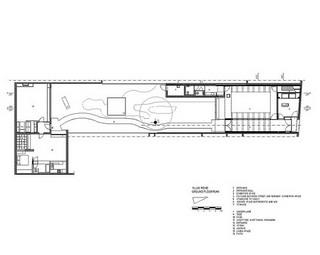
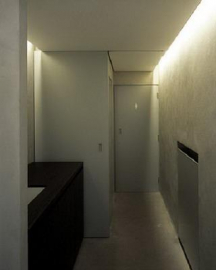
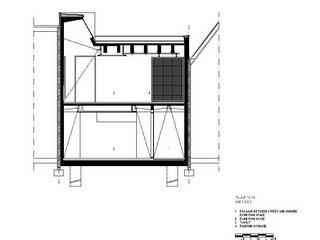
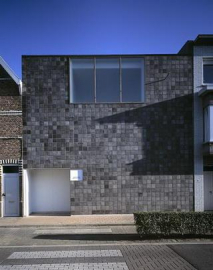
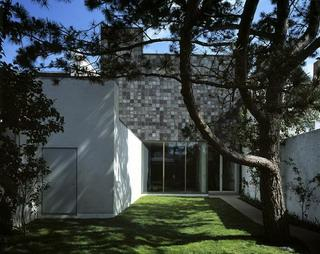
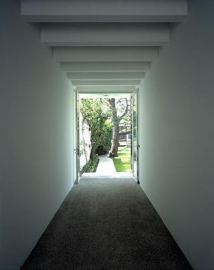
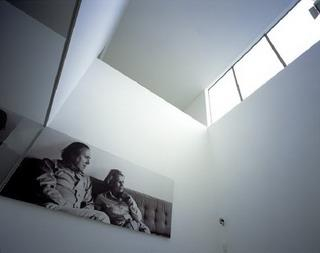
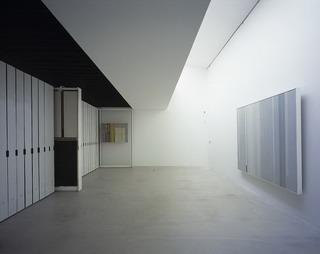
 copy.jpg)
 copy.jpg)
